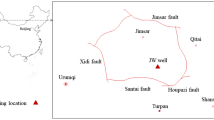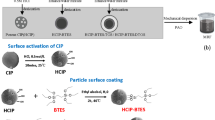Abstract
Ritter and Drake1 have proved the usefulness of measuring the penetration of mercury under pressure, in order to elucidate the pore-size distribution of various substances. From elementary theory, it follows that for the radius r
p of pores filled at a pressure p:  where σ is surface tension and θ is contact angle. Substitution of σ = 480 dyne/cm. and θ = 140° gives:
where σ is surface tension and θ is contact angle. Substitution of σ = 480 dyne/cm. and θ = 140° gives:  .
.
This is a preview of subscription content, access via your institution
Access options
Subscribe to this journal
Receive 51 print issues and online access
$199.00 per year
only $3.90 per issue
Buy this article
- Purchase on Springer Link
- Instant access to full article PDF
Prices may be subject to local taxes which are calculated during checkout
Similar content being viewed by others
References
Ritter, H. L., and Drake, L. C., Indust. Eng. Chem. Anal., 17, 782 (1945).
For a recent review, see Carman, P. C., J. Phys. Chem., 57, 56 (1953).
Kiperman, S., and Temkin, M., Acta Physicochim. (U.S.S.R.), 21, 267 (1946).
Author information
Authors and Affiliations
Rights and permissions
About this article
Cite this article
ZWIETERING, P., KOKS, H. Pore-Size Distribution of Porous Iron. Nature 173, 683–684 (1954). https://doi.org/10.1038/173683a0
Issue Date:
DOI: https://doi.org/10.1038/173683a0
Comments
By submitting a comment you agree to abide by our Terms and Community Guidelines. If you find something abusive or that does not comply with our terms or guidelines please flag it as inappropriate.



